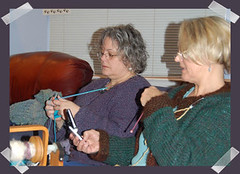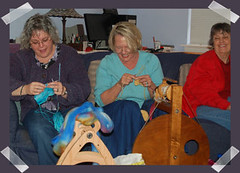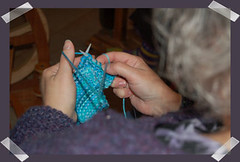Our retreat had lots of the fun elements of the real Wildflower Retreat - food, spinning, workshops and laughing without the drawback of not sleeping in our own beds!
There were six of us, Joanne, Laurie, Maxine, Marlene, Terri and me and we gathered at my house on Saturday morning. Everyone brought their wheels. Joanne brought a wonderful cake, Laurie brought cream cheese, jelly and crackers and I made Lemon Bars. So we ate and had coffee and spun.
 After lunch we had our "workshops." Marlene bought her Portuguese Knitting DVD and so we watched that. To knit "in the Portuguese way" you tension the yarn through a pin or around your neck. The yarn is wrapped with a flick of your non-dominate hands thumb (left thumb for all you right handers) and it rests either on top (for knit stitches) or underneath (for purl stitches) of your needle. This method of knitting requires much less hand stress than knitting English or Continental style.
After lunch we had our "workshops." Marlene bought her Portuguese Knitting DVD and so we watched that. To knit "in the Portuguese way" you tension the yarn through a pin or around your neck. The yarn is wrapped with a flick of your non-dominate hands thumb (left thumb for all you right handers) and it rests either on top (for knit stitches) or underneath (for purl stitches) of your needle. This method of knitting requires much less hand stress than knitting English or Continental style. Laurie and Joanne tried it out while the rest of us kept spinning. There were some fits and starts. Joanne thought she was doing the knit stitch, but it turned our she had learned the purl stitch. There was lots of laughing about this.
Laurie and Joanne tried it out while the rest of us kept spinning. There were some fits and starts. Joanne thought she was doing the knit stitch, but it turned our she had learned the purl stitch. There was lots of laughing about this.
At the real Wildflower Retreat, Cindy and Rita took a workshop on Viking Knitting where they made bracelets. They texted us a photo of their bracelets,so of course we had to send them photos of our Portuguese Knitting Workshop!
Our second "workshop" was the Patsy Zawistoski DVD on Spinning Cotton, Silk and Flax. It made me want to get my cotton sliver out and spin it. That just may be the next thing on my wheel since I was able to finish plying the fiber we dyed at the Winter Fiber Fun Retreat yesterday.
 After everyone left, I searched YouTube for
After everyone left, I searched YouTube for Portuguese Knitting and found several good videos of the technique. I spent the evening learning how to do it - left handed of course! I managed several rows of the kitchen towel that I am knitting. While I might not totally switch to this technique, I am glad to have it in my bag of tricks and will keep trying it.
We had a really fun day. It was so nice to be able to get together with good friends and share the crafts that we are passionate about.
It did help make up for not being able to go to Wildflower this year.







.jpg)



